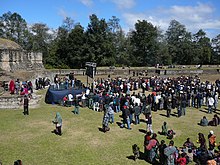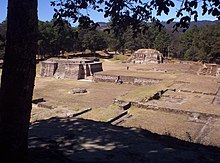Iximche
Excavators uncovered the poorly preserved remains of painted murals on some of the buildings and ample evidence of human sacrifice.[10] Conquistador Pedro de Alvarado was initially well received in the city in 1524 and the Kaqchikel kings provided the Spanish with native allies to assist in the conquest of the other highland Maya kingdoms.[18] United States President George W. Bush visited the site in 2007,[19] and in the same year Iximche was the venue for the III Continental Summit of Indigenous Peoples and Nationalities of Abya Yala.[38] The Kʼicheʼan peoples (including the Kaqchikel, the Kʼicheʼ and others) had received strong influences from central Mexico since the time of the great Early Classic metropolis of Teotihuacan.[41] Kʼiqʼab prevented his nobles from making war on the Kaqchikel for the remainder of his life, giving his former allies the time to establish their own kingdom and prepare its defences.[8] On 11 August 1521, Belehe Qat and Cahi Imox were chosen as lords of the city after the deaths of Hun-Iqʼ and Lahuh-Noh, the previous kings.[49] The Kaqchikel kings provided native soldiers to assist the conquistadors against continuing Kʼicheʼ resistance and to help with the defeat of the neighbouring Tzʼutuhil kingdom.[50] Pedro de Alvarado rapidly began to demand gold in tribute from the Kaqchikels, souring the friendship between the two peoples.[51] A couple of years later, on 9 February 1526, a group of sixteen Spanish deserters burnt the palace of the Ahpo Xahil, sacked the temples and kidnapped a priest, acts that the Kaqchikel blamed on Pedro de Alvarado.[52] Conquistador Bernal Díaz del Castillo recounted how in 1526 he returned to Iximche and spent the night in the "old city of Guatemala" together with Luis Marín and other members of Hernán Cortés's expedition to Honduras.[54] The Spaniards abandoned Tecpán in 1527, due to the continuous Kaqchikel attacks, and moved to the Almolonga Valley to the east, refounding their capital on the site of today's San Miguel Escobar district of Ciudad Vieja, near Antigua Guatemala.[56] American diplomat and writer John Lloyd Stephens described the ruins, which he called Patinamit, after he visited Iximche with English artist Frederick Catherwood and in 1840.[56] In Spanish Colonial times Iximche was the focus of a syncretic cult worshipping a relic from the ruins that had been transferred to the church in Tecpán.[58] Robert Wauchope carried out a ceramic study of Iximche in the 1940s on behalf of the Middle American Research Institute of Tulane University and published his work in 1948–1949.[20] The meeting's closing "Declaration of Iximche" committed delegates to a struggle for social justice and against "neoliberalism and other forms of oppression.[17] Modern aj qʼijab' (Maya priests often referred to as "daykeepers" in English) arrive as pilgrims at Iximche from throughout the Guatemalan Highlands.[62] Tourist facilities at the site include visitor parking, a small museum, a picnic area and a football field.[54] The modern entrance to the site is on the northern side of the ruins and includes visitor parking, a small museum, a picnic area and a football field, as well as the custodian's house.[69] The Xahil Palace was destroyed by a major fire that resulted in the collapse of the adobe walls and it may be that this was the complex where Pedro de Alvarado was lodged with his Spanish soldiers.[37] Three-legged metates (a kind of mortar) were frequently recovered from the excavations and black obsidian blades were found in great quantities.[75] It had a triple doorway divided by columns and was built from adobe covered with plaster, the columns and walls on eithers side of the doorways were painted with decorations, traces of red, yellow and blue were found by archaeologists, these colours were applied to designs marked out onto a thin cap of clay with a pointed instrument.[76] At the southwest corner of Temple 2 is a low platform that bore painted murals that had a skull with crossed longbones upon two bands of decoration.[101] Excavations uncovered two levels of plaster flooring, indicating that the ballcourt had been built during the second of the three main phases of construction at Iximche, dating it to about AD 1500.[106] Thirty-six skulls were analysed by archaeologists, of these 25 show evidence of decapitation, a sacrificial practice commonly represented in Maya art from the Classic Period.[108] Less than 3% of the analysed skulls showed evidence of iron deficiency anemia, a very low percentage compared with remains recovered from Copán and Altar de Sacrificios (64% and 88% respectively).[109] Half of these infections left evidence in the maxillary sinus, this suggests a fairly high level of airborne pathogens in the environment.[109] Tooth enamel analysis was carried out on 19 individuals and revealed hypoplasia in the teeth of 89% of these, indicating a high level of poor health in the first 7 years of childhood.[112] On each arm he wore a bracelet fashioned from the occipital bone of a human skull and engraved with fine designs that included birds and stars hanging from a Mexican-style celestial band.[104] The remains dated from the earlier phase of occupation of Iximche and the deceased had died in battle from a blow to the head from a blunt instrument.[113] The burial has been tentatively identified as that of one of two sons of Wuqu-Batzʼ of the Xahil clan, who died in the Kaqchikel wars of expansion,[114] either Chopena-Tzʼiʼkin Uka or Chopena-Tohin.









Tecpán GuatemalaChimaltenango DepartmentGuatemalaKaqchikel MayaSpanishPre-ColumbianMesoamericanarchaeological siteLate PostclassicKaqchikelpyramid-templesMesoamerican ballcourtshuman sacrificeKʼicheʼ MayaconquistadorsHernán CortésSmallpoxSpanish ConquestGuatemalan HighlandsQʼumarkajPedro de AlvaradoGuatemalan Civil WarGeorge W. BushNahuatlkingdomTecpánGuatemala CityGuatemalan departmentChimaltenangoTzʼutujilMadre Vieja Riverpine forestsAkajalKʼicheʼ Kingdom of QʼumarkajWuqu-BatzʼHun-TohChulukOxlahuh-TzʼiʼLate PreclassicMaya civilizationPeopleSocietyLanguagesWritingReligionMythologySacrificeCitiesArchitectureAstronomyCalendarStelaeTextilesMedicineCuisineWarfareHistoryPreclassic MayaClassic Maya collapseSpanish conquest of the MayaYucatánChiapasPeténTeotihuacanAnnals of the KaqchikelsLatin charactersChichicastenangoMoctezuma IIVeracruzTenochtitlanSpanish conquest of GuatemalaEscuintlaCuscatlánSantiago de los Caballeros de GuatemalaBernal Díaz del CastilloSololáLake AtitlánSpaniardsSan Miguel EscobarCiudad ViejaAntigua GuatemalaFrancisco Antonio de Fuentes y GuzmánJohn Lloyd StephensFrederick CatherwoodsyncreticGood FridayAlfred P. MaudslayRobert WauchopeMiddle American Research InstituteTulane UniversitymarimbaCongress of the Republic of GuatemaladaykeeperstemplespalaceszoomorphicmicaceouscomalsZaculeuMixco Viejometatesmortarobsidianpentatoniccrossbowlime plastermatrixincense burnerspyramidalsummer solsticetalud-tablerostuccobacabstongue piercingMixtectzompantliEarly PostclassicXibalbagladiatorial sacrificeTlalocMaya artiron deficiency anemiaCopánAltar de Sacrificiosmaxillary sinuspathogens